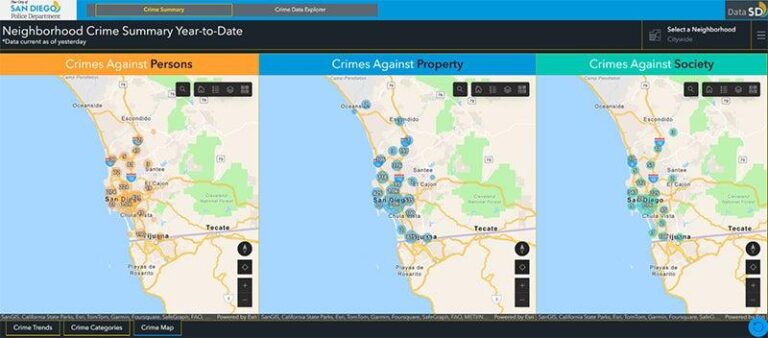For the third consecutive year, San Diego has been recognized as one of the safest large cities in the United States, according to recently released statistics from the San Diego Police Department (SDPD). The data, highlighted in the Times of San Diego, underscores the city’s ongoing commitment to public safety and effective law enforcement strategies amid challenges faced nationwide. This consistent ranking reflects positive trends in crime reduction and community engagement, positioning San Diego as a leading example of urban safety on a national scale.
San Diego Maintains Reputation as One of the Safest Large Cities in America
San Diego’s consistent ranking among the safest large cities in America is reinforced by the latest statistics from the San Diego Police Department (SDPD). For the third consecutive year, crime rates have remained significantly below the national average, highlighting the city’s effective law enforcement strategies and strong community engagement programs. Key areas such as violent crime, property crime, and theft continue to show marked declines, underscoring the effectiveness of proactive policing and neighborhood partnerships.
Highlights of the SDPD statistics include a notable reduction in:
- Violent crimes by 7% compared to the previous year
- Residential burglaries down by 10%
- Theft and vehicle break-ins decreased by 5%
| Crime Type | Percentage Change (YoY) |
|---|---|
| Violent Crime | -7% |
| Residential Burglary | -10% |
| Theft & Vehicle Break-ins | -5% |
Key Factors Behind San Diego Police Department’s Success in Crime Reduction
San Diego’s remarkable decline in crime rates is the result of several strategic initiatives implemented by the police department. Central to their approach is the integration of community policing, which fosters trust and collaboration between officers and residents. This method not only helps in proactive crime prevention but also encourages citizens to become active stakeholders in neighborhood safety. Officers are regularly deployed on foot and bike patrols in key areas, creating a visible presence to deter potential offenders.
Moreover, technology plays a pivotal role in the department’s success. Investments in advanced data analytics enable law enforcement to identify crime patterns and allocate resources efficiently. The following table highlights some of the key factors and their impacts on crime reduction:
| Factor | Impact |
|---|---|
| Community Engagement | Improved trust & cooperation |
| Data-Driven Patrols | Targeted crime hotspots |
| Use of Technology | Faster response times |
| Officer Training | Enhanced conflict de-escalation |
- Collaborative task forces that address gang violence and drug-related crimes effectively.
- Outreach programs focusing on youth engagement to prevent future criminal activity.
- Transparent communication with the public through regular updates and community meetings.
Community Policing Strategies Drive Continued Safety Improvements
In San Diego, a comprehensive approach to community engagement has been pivotal in maintaining the city’s impressive safety record. Officers routinely work alongside residents, businesses, and local organizations to develop tailored solutions that address specific neighborhood concerns. This collaborative environment fosters trust and encourages proactive crime prevention, ensuring that the community remains connected and vigilant. Key initiatives include regular neighborhood meetings, youth outreach programs, and dedicated patrols in high-traffic areas, all of which contribute to a visible police presence and quick response times.
Data collected over recent years highlight how these strategies translate into measurable outcomes. For example, the implementation of a community policing task force correlated with a notable decrease in property crimes and an increase in the public’s confidence in local law enforcement. The following table illustrates some core metrics from the past three years, showcasing San Diego’s continued progress:
| Year | Property Crime Reduction (%) | Community Meeting Attendance | Response Time (Minutes) |
|---|---|---|---|
| 2021 | 8.7 | 4,500 | 5.2 |
| 2022 | 10.3 | 5,200 | 5.0 |
| 2023 | 11.8 | 5,800 | 4.7 |
Recommendations for Sustaining and Enhancing Public Safety in San Diego
To maintain San Diego’s commendable safety record, continuous investment in community policing remains essential. Strengthening relationships between officers and neighborhood residents fosters trust and cooperation, crucial elements in crime prevention. Additionally, leveraging technology such as advanced data analytics and surveillance tools can enhance real-time response capabilities and predictive policing measures. Community engagement programs, including youth outreach and violence intervention initiatives, should also be expanded to address root causes and foster long-term public safety.
Strategic allocation of resources, guided by up-to-date crime statistics, will ensure targeted and efficient deployment of personnel. Public safety can be further improved by fostering partnerships between law enforcement, local government, and civic organizations. Below is a summary of key recommendations to sustain and enhance our city’s safety:
- Expand Community Policing: Increase foot patrols and neighborhood engagement efforts
- Enhance Technology Integration: Implement predictive analytics and smart surveillance systems
- Increase Preventative Programs: Support youth mentorship and violence prevention initiatives
- Optimize Resource Deployment: Use data-driven approaches to allocate personnel effectively
- Strengthen Partnerships: Collaborate with nonprofits, businesses, and government agencies
| Focus Area | Proposed Action |
|---|---|
| Community Engagement | Monthly neighborhood forums |
| Technology | Real-time crime mapping |
| Youth Programs | Expanded after-school activities |
| Resource Management | Data-driven patrol assignments |
| Public Partnerships | Joint safety task forces |
Key Takeaways
As San Diego continues to rank among the safest large cities in the nation for the third consecutive year, the SDPD’s latest statistics underscore the effectiveness of community policing and public safety initiatives. While challenges remain, these encouraging numbers highlight the city’s commitment to maintaining a secure environment for residents and visitors alike. Moving forward, sustained efforts and collaboration between law enforcement and the community will be essential in preserving San Diego’s reputation as a model for urban safety.







